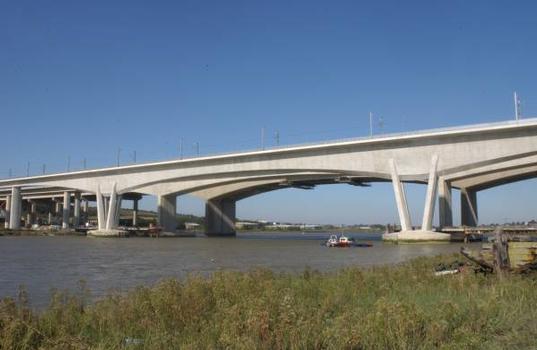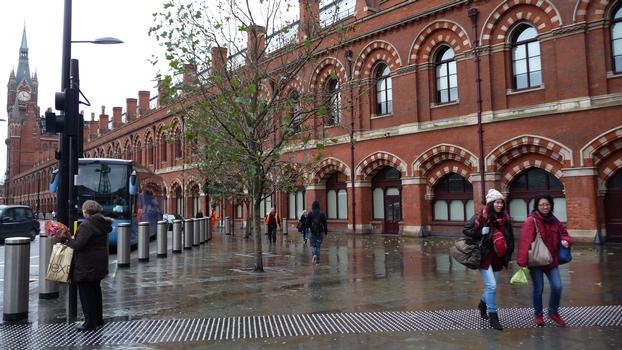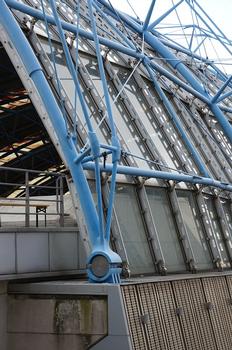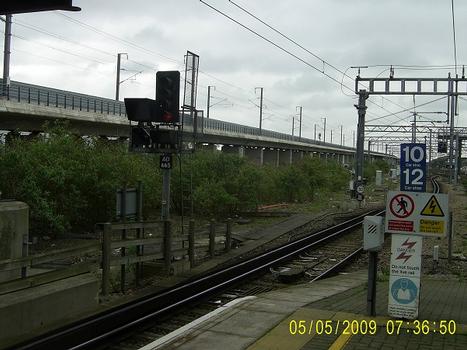General Information
| Other name(s): | Channel Tunnel Rail Link (CTRL) |
|---|---|
| Beginning of works: | 1998 |
| Completion: | 2007 |
| Status: | in use |
Project Type
| Function / usage: |
High-speed rail line |
|---|
Location
| km | Name |
Technical Information
Dimensions
| total length | 109 km | |
| length of bored tunnels | 23 km | |
| number of road bridges | 62 | |
| number of rail bridges | 60 | |
| number of footbridges | 30 | |
| 1 (EuroTunnel - Fawkham Junction) | ||
|---|---|---|
| Section | length | 74 km |
| 2 (Southfleet - Saint Pancras) | ||
| Section | length | 39 km |
Quantities
| ballast | 850 000 t | |
| excavated material | 14 000 000 m³ | |
| volume of earthworks | 5 000 000 m³ |
Design Loads
| design speed | 300 km/h |
Cost
| cost of construction | United States dollar 5 200 000 000 |
Chronology
| December 1986 | The Channel Tunnel Rail Link Act is passed by British parliament. |
|---|---|
| February 1987 | The Channel Tunnel Act receives Royals Assent. Waterloo is identified as England's first international train terminal. |
| July 1987 | King's Cross is chosen as second terminal by British Rail to provide additional capacity to cope with Channel Tunnel trains. |
| July 1988 | Four potential routes are identified by British Rail. |
| December 1988 | The UK government decides to involve the private sector and six consortia are invited to tender for a BOT scheme. |
| January 1989 | The Channel Tunnel Rail Link Team is set up within British Rail. |
| March 1989 | British Rail chooses the preferred corridor. |
| October 1991 | The Government decides on an alternative route developped by Ove Arup & Partners using an easterly approach. |
|
March 1993
— October 1993 |
Public consultation. |
| January 1994 | The UK Government confirms most of the route and decides on Saint Pancras as the London terminus. |
|
January 1994
— March 1994 |
Further public consultations. |
| April 1994 | Nine bids are received to pre-qualify for a competition to select the private sector BOT promoter for CTRL. |
| May 1994 | Official opening of the Channel Tunnel. |
| June 1994 | Four consortia are pre-qualified and invited to tender: Green Arrow (JV of Hochtief, Costain, Nishimatsu, Siemens), Eurorail (BICC, GEC, HSBC Holdings, National Westminster Bank, Seeboard, Trafalgar House); LCR (Arup, Bechtel, Blue Circle, Halcrow, National Express, Virgin, Warburg); Union Link (AEG, WS Atkins, Philipp Holzmann, Mowlem, Spie Batignolles, Taylor Woodrow). |
| August 1994 | The UK Government announces an intermediate station at Ebbsfleet. The competition is launched to find the BOT consortium to build the CTRL. |
| November 1994 | Introduction of the CTRL Bill to the House of Commons. |
| June 1995 | The LCR and Eurorail consortia are shortlisted. |
| December 1995 | The announcement of the winner is postponed to allow for more time to review and revise bids. |
| February 1996 | The Channel Tunnel Treaty is signed by Margaret Thatcher and François Mitterand. |
| February 1996 | The UK Government and the LCR consortium sign the contract to design, build, finance and operate the CTRL. Ownership of European Passenger Services Ltd, the UK arm of the Eurostar train operations, is transferred to LCR. |
| December 1996 | The CTRL bill receives Royal Assent. |
| March 1997 | Creation of the Rail Link Engineering (RLE) consortium. |
| April 1997 | First tenders are issued. |
| June 1997 | Begins of advance works diverting 15 km of electricity cables und der the A2 near near Gravesend (Kent). |
| October 1998 | Construction of Section 1 begins. |
| March 1999 | Contract 420 for mid-Kent section is awarded to Hochtief/Norwest Holst, valued at around 85 million pounds. |
| January 2000 | Systemwide constact 570 (valued at 120 million pounds) for design and supply of track, overhead lins and electrical and mechanical systems for Section 1 is awarded to AMEC Spie Rail Systems. |
| February 2000 | The last contract for Section 1 - systemwide contract 550 valued at 56 million pounds - is awarded to the CCA consortium made up of CSEE Transport, Corning Communications and Amey Rail. The contract is to procure, install, test and commission the signalling, train control and communication systems. |
| July 2000 | Bridge House, a 16th century listed timber-framed house, is moved sideways (55 meters) to a new location away from the alignment of the CTRL route. |
| 2001 | Construction of Section 2 begins. |
| January 2001 | First major contracts are awarded for Section 2. Contract 230 is awarded to Skanska Construction UK, Contract 320 to Hochtief and J Murphy & Sons. |
| February 2001 | Contracts 135, 220, 240 and 250 are awarded. |
| May 2001 | First dedicated tracks are laid at Fawkham Junction (Kent). |
| July 2001 | Completion of North Downs Tunnel, 5 months ahead of schedule and 5 million pounds below budget. |
| July 2001 | Groundbreaking for Section 2 by Transport Minister John Spellar in Stratford. |
| August 2001 | Saint Pancras extension, contract 105, is awarded. The contract is later combined with no. 108. |
| January 2002 | Contract 342 worth 120 million pounds is awarded. It covers the construction of 3.5 km of the CTRL between Thames Tunnel and Section 1 interface at Pepper Hill. |
| July 2002 | Contract 588 for the mechanical and electrical systems of Section 2 is awarded. |
| August 2002 | Track and overhead catenary systems contract 576 is awarded to ACT Joint Venture. |
| September 2002 | Carillion Rail is awarded the first maintenance contract M01 for Section 1. |
| October 2002 | Tender invitations are sent out for contracts 232 and 340 which include the Stratford and Ebbsfleet stations, respectively. |
|
February 2003
— April 2003 |
Section 1 is energized. The overhead current of 25 000 Volts powers the trains between Fawkham Junction and Channel Tunnel. |
| April 2003 | The Camden Council transport depot (contract 125) is opened. |
| July 2003 | The UK rail an speed record is broken by a Eurostar train reaching 334.7 km/h on Section 1. |
| 27 September 2003 | Opening of the first section to regular train traffic. |
| March 2006 | Testing to begin on Section 2. |
| March 2007 | Construction of Section 2 complete. |
Notes
LCR = Bechtel Ltd + SG Warburg & Co + National Express Group PLC + SYSTRA + London Electricity PLC + Arup Group Ltd + Sir William Halcrow & Partners Ltd.
RLE = Rail Link Engineering = Bechtel Ltd + Ove Arup & Partners Ltd + Sir William Halcrow & Partners Ltd + SYSTRA.
Expected travel times in 2007:
- Paris to St Pancras: 2h20
- Brussels to St Pancras: 2h35
- up to 8 Eurostar Trains per hour.
Participants
Relevant Web Sites
-
BBC News: Faster Channel rail service begins (28.09.03)

-
BBC News: High-speed Channel link opens (16.09.2003)

-
BBC News: Train smashes London-Paris record (27.09.2003)

-
Erik's Rail News: 208.0 mph / 334.7 km/h - Eurostar Breaks UK High-speed Record

-
Rail-Net: CTRL Over speed testing

-
Railway Technology: Channel Tunnel Rail Extension Project, United Kingdom

-
TGVweb: System Maps

-
UK Stationery Office: Channel Tunnel Rail Link

Relevant Publications
- (2003): Advancing under London. In: Civil Engineering Magazine, v. 73, n. 12 (December 2003).
- Arup and the Channel Tunnel Rail Link. In: Arup Focus (September 2003), pp. 1-6.
- (2004): Bored tunnels. In: The Arup Journal, v. 39, n. 1 ( 2004), pp. 22-28.
- (2004): Bridges. In: The Arup Journal, v. 39, n. 1 ( 2004), pp. 33-39.
- Cantilever segmental bridges built using DYWIDAG Formtravellers, Taiwan. Construction of Bridges with Balanced Cantilever Method in Taiwan High Speed Rail Project C291, Tainan, Taiwan. In: DSI Info, n. 12 ( 2003- 2004), pp. 20.
- About this
data sheet - Structure-ID
10000038 - Published on:
11/02/2001 - Last updated on:
20/01/2022



.jpg)









